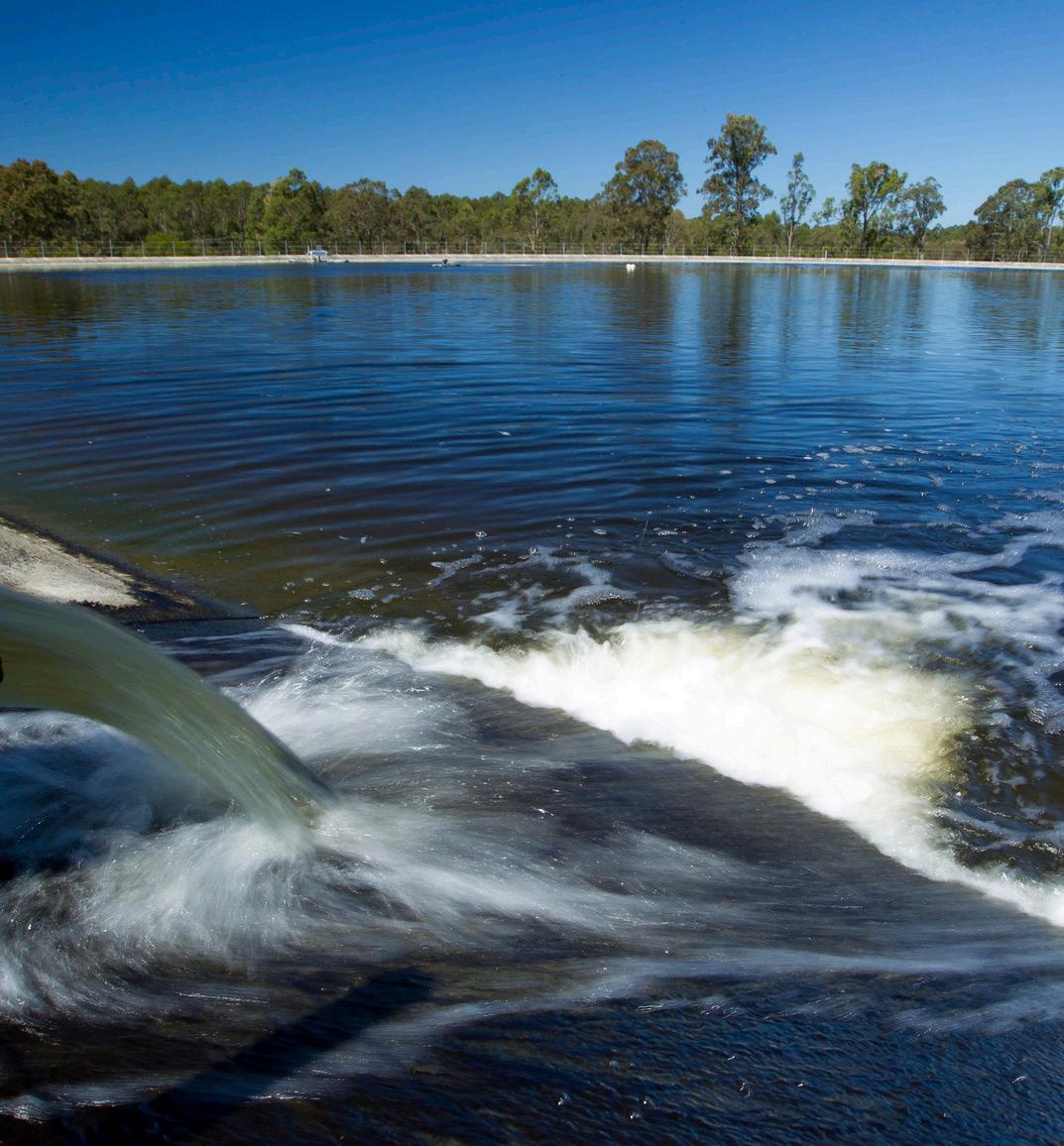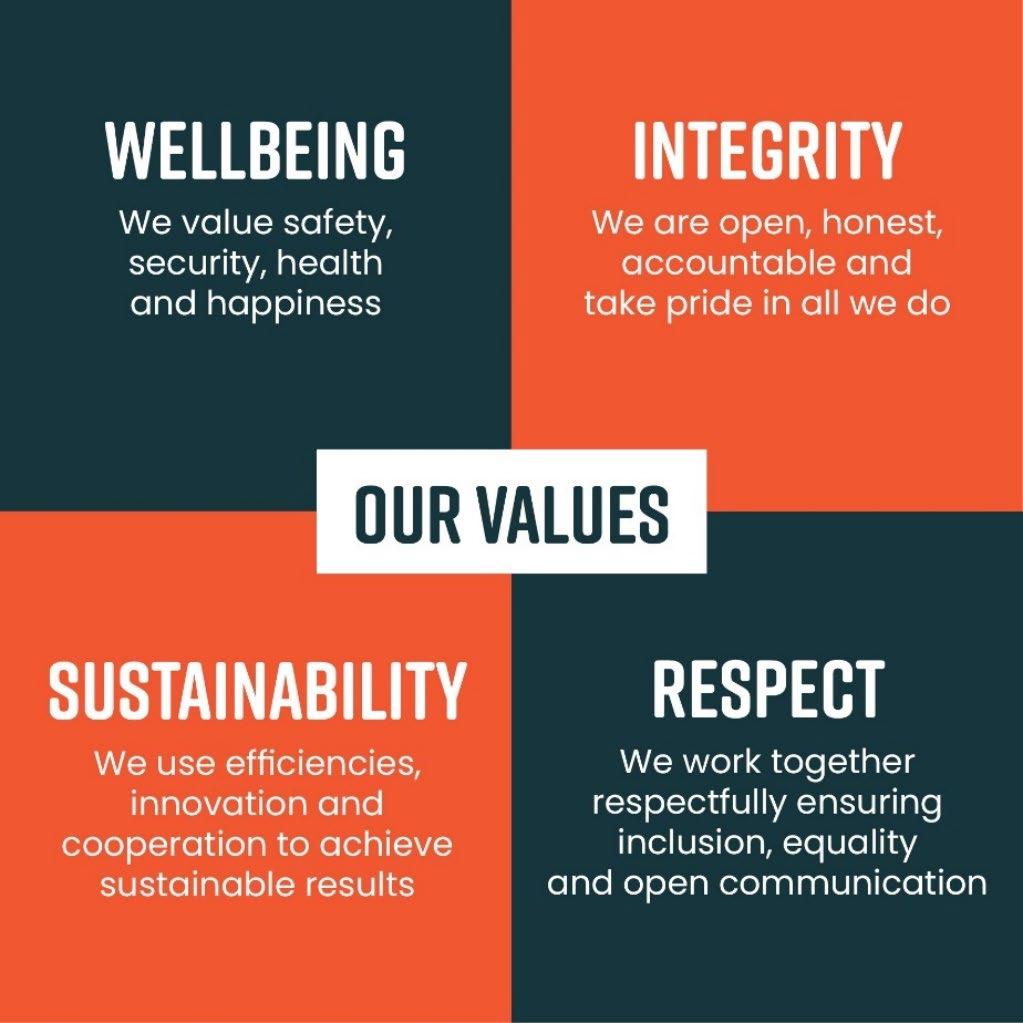WATER AND SYSTEMS

Contents Introduction 4 Context .4 Background ..........................................................................................................................6 Our Vision & Values 7 Strategic Risk Review 8 W&S Strategic Objectives 11 The Strategic Roadmap 13 Key Strategic Initiatives 13 Initiatives to Maintain 14 Maintain Customer Focus 14 Maintain Operational Response Capability ........................................................................14 Maintain In-House Expertise 16 Maintain Compliance Results 17 Initiatives to Improve 17 Improve Culture and Wellbeing ..........................................................................................18 Improve Operational Works Planning 19 Improve Living Asset Management 20 Improve Long-Term Financial Sustainability ......................................................................22 Initiatives to Grow 23 Grow our Community’s Water Literacy 23 Grow our Targeted Asset Renewals ..................................................................................24 Grow our Planned Project Delivery Capability ...................................................................26 Manage Workforce Planning Risks 26

Acknowledgement of Country
We acknowledge the traditional custodians of the land on which we work and live, the Gathang-speaking people and pay our respects to all Aboriginal and Torres Strait Islander people who now reside in the MidCoast Council area. We extend our respect to Elders past and present, and to all future cultural knowledge holders.
Introduction
MidCoast Council’s Water & Systems group are responsible for delivering safe, secure, efficient, sustainable, and affordable water supply and sewerage services to 40,000 customers across the MidCoast local government area. We protect public health and the environment and support economic development and liveability.
Context
This strategic plan is one of many strategic documents that make up MidCoast Council’s Integrated Planning and Reporting Framework and is alignment with the Community Strategic Plan as described in Figure 1. The Water and Systems group has two key strategic plans which feed into the framework. These are:
• The Integrated Water Cycle Management (IWCM) Strategic Plan, and;
• The Water & Systems Strategic Business Plan (SBP).
The IWCM Strategy is a local water utility's strategy for the provision of appropriate, affordable, cost-effective and sustainable urban water services that meet community needs and protect public health and the environment. It lays the foundation for the long-term financial plan in terms of the creation, renewal and operation of water and wastewater assets over a 30-year timeframe.
The Strategic Business Plan assesses the current environment of the water business, both internally and externally. It establishes future goals and targets and describes the initiatives it will implement to reach them.

Together, the IWCM and SBP (and their supporting documents) address each of the 12 strategic planning outcome areas identified in the ‘Regulatory and assurance framework for local water utilities’
Figure 1: Water Strategies and the Intergrated Planning and Reporting Framework
Background
The last Water SBP was completed in 2018. At that time, Local Water Utilities were required to comply with the requirements and timeframes of the NSW Government’s Best-practice Management of Water Supply and Sewerage Guidelines 2007. These requirements include:
• Preparing and implementing a 30-year Integrated Water Cycle Management (IWCM) Strategy
• Preparing and implementing a 20–30-year Strategic Business Plan, Financial Plan and associated asset management plans
• Annual Performance Monitoring, including preparing an annual Action Plan to review the council’s performance and to identify and address any areas of underperformance. The review also includes whether the current typical residential bill is in accordance with the projection in the Strategic Business Plan and any proposed corrective action
This process of strategic planning was detailed and Local Water Utilities (LWUs) were accountable to the NSW Office of Water to deliver the strategic planning as prescribed.
In 2022, changes were made to allow LWU’s more flexibility in how strategic planning was managed. The new regulatory and assurance framework was applied to local water utilities in regional NSW from 1 July 2022. Under the new framework, an IWCM and Strategic Business Plan are no longer required and strategic planning can take whatever format the LWU sees fit.
As MidCoast Council was partway through preparing the strategic documents under the 2007 requirements, we continue to have an IWCM and SBP as our two key strategic documents. However, liberty has been taken with the content of these documents to ensure that they meet the outcomes-focused approach required by the new framework. Essentially, these documents get to the heart of Council’s strategic plans for the Water & Systems group and avoid repetition of items that have been covered elsewhere in Council’s strategies, plans, policies and supporting documents
Our Vision & Values

The Water & Systems group of MidCoast Council is a high performing team where we are always striving to be better, work collaboratively and be trusted.

Strategic Risk Review
The provision of water supply and sewerage services is continuing to undergo significant change and reform. Customers, the wider community, and Government are demanding increased accountability, service levels, and efficiency from their water utilities. Regulators are imposing more stringent environmental protection, public health and workplace health & safety regulations. Across the state, aging assets and infrastructure are fast approaching the point where significant investment will be required in asset renewal. This pressure to manage assets, coupled with climatic uncertainty and economic challenges, mean that the demands faced by local water utilities are increasing.
 Figure 2: Current risks affecting NSW Local Water Utilities
Figure 2: Current risks affecting NSW Local Water Utilities
The NSW Department of Planning and Environment are taking a risk-based approach to regulation and assurance of MidCoast Council’s water and sewerage services. This means that they are focused on oversight, support and intervention based on analysis of the risk profile for each local water utility, and across the sector.
We have recently completed comprehensive risk reviews across each of our departments. We found that, whilst some risks were specific, several key risks were common throughout the departments. The key risks identified were:
• Attraction and retention of qualified, skilled and motivated staff
• Identification, prioritisation and repair of defective infrastructure
• Safety, health and wellbeing of staff and contractors
• Delivery of the adopted capital works and renewal program
• Staff culture and performance
water and sewerage services agreement
Our responsibilities
•Minimise interruption to water services, or variation to water quality
•Respond to issues in the water network as soon as practicable
•Provide a pressure of not less than 150kPa to your water meter
•Minimise water losses from our network
•Bill you quarterly for the water you use
•Give you more than 48 hours notice for planned interruption to services
•Minimise inconvenience to you when sewer overflows occur due to an issue with our system; and efficiently and adequately clean the affected area
•Respond to issues in our wastewater network as soon as practicable but always within 6 hours

Your responsibilities
• Use water efficiently
•Protect your water meter from damage
•Ensure that no stormwater from your property enters our sewerage network
•Notify us of sewage spills and unusual odours in our network
•Pay your bill on time
• Notify us of significant changes to flow, quality, pressure and any leaks in our water network
•Dispose of substances correctly to keep the nasties out of our sewerage network
midcoast.nsw.gov.au
W&S Strategic Objectives
MidCoast Council’s Water & Systems division has identified the following strategic objectives which sets the direction for this Strategic Business Plan. The five key objectives that have been identified for long term success are:





Staff feel valued, safe, well, happy and respected at work and have a sustainable workload
We know our assets and our role in managing them in a sustainable, planned way
We deliver quality water & sewerage services to a knowledgeable community
Staff are competent, confident and consistent in the way they perform their work
We have enough budget and resources to deliver the necessary services and we understand the financial drivers and constraints
 Figure 3: Links to other Council Plans and Strategies
Figure 3: Links to other Council Plans and Strategies
The Strategic Roadmap
This Strategic Business Plan sets a roadmap for achieving our organisational objectives. The Roadmap includes twelve strategic initiatives which identify how we intend to take action to:
• Maintain the best of what we do,
• Improve on initiatives where work has already begun, and;
• Grow in the areas where we can make the greatest impact
Key Strategic Initiatives
MAINTAIN IMPROVE GROW
Customer focus
Operational response
In-house expertise
Compliant services
Culture & Wellbeing
Community Water Literacy
Operational Works Planning Targeted Asset Renewal
Living Asset Management
Planned Project Delivery
Long Term Financial Sustainability Manage Workforce Planning Risks
“Maintain” initiatives include focus areas in which the Water & Systems group are currently performing to a high level. These initiatives may benefit from minor improvements however, no major effort is required. The purpose of their inclusion in the Strategy is to ensure that focus from these areas is not lost once substantial effort is applied to the improvement and growth initiatives.
“Improve” initiatives are areas where efficiency gains can be made. Generally, some work has already begun in these areas, but a concentrated, consistent effort is required in order to make further progress and reap the efficiency gains possible.
“Growth” initiatives represent the areas with the greatest potential for step change improvements. Optimising performance across these areas is expected to have roll-on effects across all aspects of the water business.
Initiatives to Maintain
Maintain Customer Focus
This initiative aims to maintain the quality of the service that we currently provide in the effective delivery of timely service to our customers.
Currently, we provide a response to customer operational requests within four (4) hours wherever possible. A customer request prioritisation process is in place in order to manage customer requests in line with the level of identified risk. Within this process, potential public health & safety and/or environmental compliance risks trigger immediate investigation into the issue.
A quality assurance program is in place to ensure that services delivered to customers, especially when close to their property boundary, are provided in a way that minimises impacts to the customer and the community such as limiting the amount of time and the number of customers affected by a service outage. Where impacts are not able to be completely mitigated, we ensure that we communicate well with those affected. During extreme events, the Water & Systems team prioritises our most critical assets to ensure that as few customers are impacted as is necessary.
Areas for improvement
Our staff regularly receive positive feedback from the community on the services that are provided however there is always more we can do to be “Better Every Day”.
Over the life of this strategy, supported by the Operational Works Planning initiative, we aim to maintain our customer focus by:
• Incorporating lessons learnt from customer compliments and complaints into our continuous improvement processes
• Identifying ways to better prioritise customer requests based on risk level
• Provide additional training to ensure that staff are able to provide quality services to customers and understand any associated risks
• Improve customer communication and education
• Continue to identify and fix leaks to build trust within the community.

Maintain Operational Response Capability
This initiative aims to maintain the responsiveness of our operational services in times of intense pressure.
Our operational staff have an intimate knowledge of our network and treatment assets. During critical events, such as critical asset failures, floods, fires and drought, our teams work together, and make decisions at the right level, to ensure that critical services are restored in a timely manner.
When responding to operational events, staff look out for one another by checking in regularly and ensuring that fatigue is managed. In emergency situations, our people show up and step up.
Regulatory compliance is front of mind during critical events. When compliance cannot be maintained, our staff provide timely, open and transparent reporting to our regulators, our organisation and the community and take appropriate steps to minimise harm.
Areas for improvement
Maintaining our operational response capability over the life of this strategy, is supported by several other initiatives:
• The Manage Workforce Planning Risk initiative will inform the Workforce Management Plan to address issues related to staff retention and succession planning to ensure that knowledge of our systems and assets is maintained over time
• The Targeted Asset Renewal initiative will reduce the likelihood of critical asset failure
• The recently created Operational Works Engineer role will continue to ensure that operational staff are suitably trained and have the documentation necessary to respond during an event (e.g. SOPs, ERPs, etc)

Maintain In-House Expertise
This initiative aims to maintain the current level of in-house expertise in the Water & Systems team
The MCC team are well-trained professionals with the skills and capability needed for the range of complex activities that need to be undertaken. Whilst consultants and specialist contractors are often used for resource levelling, rarely does the expertise provided outperform the in-house capability.
Alternative operating models are available for Water & Systems functions however, there are huge benefits to maintaining the level of in-house expertise that exists within Council, particularly in the specialist focus areas of strategic planning, water & sewer modelling, minor construction, design, project management, Geospacial Information Systems (GIS) mapping, treatment operations, response & Supervisory Control and Data Acquisition (SCADA)
Maintaining this expertise in-house ensures that we have local knowledge and understanding of our assets and systems, a strong commitment to community service (as our staff are part of the community) as well as consistency in standards, practices and procedures which helps to ensure ongoing compliance to regulatory, safety, quality and environmental requirements
Some challenges Council faces in maintaining the current level of in-house expertise over the long term is the aging workforce and lack of succession planning for adequate time for knowledge transfer, staff turnover with pressures from private industries and other government departments offering higher pay and conditions and a lack of opportunities for progression as people outgrow their roles
Areas for improvement
Maintaining our in-house expertise over the life of this strategy, is supported by the Manage Workforce Planning Risk initiative, it also requires:
• Continued support of graduate, apprentice and trainee programs
• Improved staff development and awareness of key standards including WSAA, MCC specifications and drawings.
• Creating opportunities for rotations within operations and construction teams for increased knowledge sharing

Maintain Compliance Results
This initiative aims to maintain the current level of compliance with regulatory requirements MidCoast Council’s Water Services are governed by the NSW Local Government Act 1993 and the Water Management Act 2000, as well as the:
• Public Health Act 2010
• Protection of the Environment Operations Act 1997
• Environmental Planning and Assessment Act 1979
• Dams Safety Act 2015
• Work Health and Safety Act 2011
• Water Act 2007 (Cth)
Currently, Council achieves a high level of compliance to the limits and guidelines set by our regulators in terms of both effluent and drinking water quality. The following graphs show the level of compliance being achieved and the improving trend over time.

Areas for improvement

Maintaining our regulatory compliance record over the life of this strategy, is supported by:
• The Targeted Asset Renewal initiative which will increase the likelihood of maintaining compliance over time by reducing asset failures and targeting the right combination of planned vs reactive renewals
• The Workforce Planning Risk initiative which will increase the likelihood of maintaining compliance over time by improving development of staff expertise and maintaining appropriate resource levels as our asset base grows We also need to:
• Stay cognizant of regulatory changes that may affect the services we deliver
• Keep pace with population growth to ensure we are not over-loading our assets
 Figure 3: Effluent and Water Quality Results
Figure 3: Effluent and Water Quality Results
0.0% 10.0% 20.0% 30.0% 40.0% 50.0% 60.0% 70.0% 80.0% 90.0% 100.0% 2017/18 2018/19 2019/20 2020/21 2021/22 2022/23 Effluent Licence Compliance 0.0% 10.0% 20.0% 30.0% 40.0% 50.0% 60.0% 70.0% 80.0% 90.0% 100.0% 2018/19 2019/20 2020/21 2021/22 2022/23 Water Quality Compliance Microbiological Physical Chemical
Initiatives to Improve
Improve Culture and Wellbeing
This initiative aims to improve the culture of our teams and the wellbeing of our team members
Operating a water utility is a 24/7, 365 per year effort. Recent years have seen unprecedented hardship for the staff working in this field as the MidCoast has been affected by drought, bushfire, multiple floods and the COVID 19 pandemic. The nation-wide skills shortage has also impacted Council’s ability to recruit and retain water staff.
Many Water & Systems staff report that they are experiencing a high level of stress and overwhelm at work. Whilst individual teams are working effectively together, there is work to be done in improving collaboration across teams throughout the broader organisation.
Addressing some of the core issues identified in each of the initiatives in this Roadmap will have the greatest impact on culture and wellbeing within the team. The Water & Systems Leadership team are committed to communicating openly, building trust and demonstrating collaboration across MidCoast Council.
Areas for improvement
Improving staff culture and wellbeing over the life of this strategy, is supported by several other initiatives:
• The Targeted Asset Renewal initiative will reduce unplanned, reactive work allowing time for more planned maintenance and a more resilient network.
• The Manage Workforce Planning Risk initiative will inform strategies for addressing issues related to prolonged vacancies reducing the workload pressure on remaining team members
• Additionally, a Culture and Wellbeing Action Plan has been developed for inclusion in Council’s 2025 Delivery Program.

Improve Operational Works Planning
This initiative aims to improve the way that we plan for and deliver our operational water services including the operation and maintenance of:
• Source water, treatment and water reticulation infrastructure
• Wastewater reticulation, treatment and disposal infrastructure, and;
• Recycled water treatment and network infrastructure.
In 2022, Council commissioned an independent review into the workplace performance of the Water and Transport operational teams. The consultant provided a list of improvement recommendations to increase efficiency and oversight across these work groups.
The recommendations included:
• Improving Contact Centre scripting and training
• Creating an operational works prioritisation process
• Introducing scheduling and time stamping
• Improving work order information using MC1 capabilities (working alongside the Business Transformation Project team)
• Producing standard work estimates
• Mapping available tool time
• Developing a consolidated works plan
We have developed an Operational Works Planning Action Plan which sets out a discrete program of work over 3-4 years using internal and external resources to deliver the actions identified above. The program will include an internal communications plan to ensure that change management is handled effectively. Efficiency improvements across the ~110 operational employees are expected to provide a very short payback period on the improvement program.
Areas for improvement
Improving operational works planning over the life of this strategy, is supported by several other initiatives:
• The Targeted Asset Renewal initiative will reduce unplanned, reactive work allowing time for more planned maintenance and a more resilient network.
• The Manage Workforce Planning Risk initiative will inform strategies for addressing issues related to prolonged vacancies enabling better workforce planning in operational teams.
• Additionally, an Operational Works Planning Action Plan has been developed for inclusion in Council’s 2025 Delivery Program.

Improve Living Asset Management
Asset management is a ‘whole of business’ function with every staff member playing their part to ensure our water and sewer assets deliver essential services to the community. This initiative aims to improve our asset management knowledge, capabilities and technologies to foster a culture of living asset management across our business.
Our $2 billion worth of water and wastewater assets requires significant ongoing investment to continue to reliably service our 40,000 customers across 10,000 square kilometres. Understanding the whole of life cycle cost of our assets is essential to efficiently operating our water business.
The term Levels of Service (LOS) is used to define explicitly the standards required from water supply and sewerage systems from the perspective of the individual customer. Levels of Service are set in order to prioritise:
1. Protection of public health
2. Protection of the environment
3. Service availability
4. Financial sustainability
In the asset management context, LOS include things like community’s appetite when it comes to the frequency, duration and magnitude of water restrictions, the level of wastewater recycling undertaken and how far MCC’s water and wastewater services should extend (e.g. whether we should service currently unserviced villages).
During the Our Water Our Future 2050 IWCM, Council consulted the community to set the LOS to be adopted over the 30-year life of that strategy. This involved finding a balance between community expectations of the services provided versus their willingness to pay. LOS will largely shape the objectives and requirements for operation, maintenance, and provision of capital works in Council’s total asset management planning. These, in turn, inform the Resourcing Strategy, which includes the Long-Term Financial Plan.
As an organisation we have prioritised the need for asset management improvement and have begun our journey to asset management maturity. We are working towards this by implementing our Asset Management Strategy and Improvement Plans with further work to develop our Asset Management Plans (AMPs) with the intent of creating a living asset management culture where staff understand and value their roles in asset driven service delivery.
The Asset Management Strategy is working towards five core outcomes:
• Providing a strong foundation/baseline for future decision making
• Integrating risk into operational, maintenance and capital investment decision making
• Establishing key business functions to facilitate and support best practice decision making
• Shifting from a reactive to informed and accountable decision culture
• Improving overall business sustainability
Areas for improvement
Improving living asset management over the life of this strategy, is supported by several other initiatives:
• The Targeted Asset Renewal initiative will reduce unplanned, reactive work allowing time for more planned maintenance and a more resilient network.
• The Planned Project Delivery initiative will address increased population and service demand, ageing infrastructure and respond to severe weather events and other climate change related impacts
• Additionally, a Living Asset Management Action Plan has been developed for inclusion in Council’s 2025 Delivery Program which includes:
• Developing Asset Management Plans to provide details of such things as criticality, condition, replacement value, expected remaining useful life, maintenance strategies, and condition monitoring methodology.
• Collaboration and Engagement with our operational and technical teams to improve asset management processes, ensure that decisions are based on current asset information, and that our people understand why we need to improve, and are motivated to make the shift.
• Moving towards being a digital utility by introducing new and mobile technologies that supports planned maintenance decisions and allows operational staff to record, review and update asset information out in the field.
• Improving our asset planning and creation processes, including policy development, along with education to enhance the use of systems to support project managers, asset managers and accountants

Improve Long-Term Financial Sustainability
This initiative aims to improve transparency and awareness of the long-term financial sustainability of Council’s Water and Sewerage Services.
From 2015 in the former MidCoast Water, there was a deliberate focus on restraining expenditure in order to correct the operating position of the sewer and water funds. This action has generally been successful. For the last 5 years, the sewer fund has achieved a surplus Operating Result before Capital, while the Water Fund has achieved this in two of the five years with the other years being a small deficit result. As a result, both funds have built healthy cash reserves. However, concern around the long-term financial sustainability of the water fund remains.
The State Government regulators require Local Water Utilities (LWUs) to implement sound pricing of services and manage finances prudently. Additionally, LWUs are required to:
• Structure its water supply and sewerage pricing to recover its revenue requirement, promote efficient use of water, and achieve equitable and affordable pricing and intergenerational equity
• Implement a cost-reflective and consumption-based tariff structure and long-term stable price path
• Set appropriate developer charges to recover the infrastructure cost of servicing growth
• Consider payment of tax equivalents and dividends
• Consider affordable access to essential water services for all customers
• ‘Ring-fence’ the water supply and sewer business fund from council’s general-purpose fund
The IWCM projects a 30-year Long-Term Financial Plan (LTFP) for the water and sewer funds. Prioritisation of works based on risk assessment and scoring is embedded in the process but must be normalised to be most effective. The IWCM LTFP is modelled to ensure its affordability over a 30-year term. However, greater effort and understanding is needed to ensure compliance with the requirements listed above.
Areas for improvement
Improving transparency and awareness of the long-term financial sustainability of Council’s Water and Sewerage Services, is supported by several other initiatives:
• The “Targeted Asset Renewal” initiative ensures that asset renewal costs are accurately incorporated in the LTFP and modelled for affordability
• The “Operational Works Planning” initiative will more accurately determine the cost of water and wastewater operations over the long term.
• Additionally, a Long-Term Financial Sustainability Action Plan has been developed for inclusion in Council’s 2025 Delivery Program

Initiatives to Grow
Grow our Community’s Water Literacy
Water is critical to sustain human existence. Water literacy involves understanding the interactions within and between natural and human dimensions of water systems to support informed decisionmaking. It is therefore critical to foster water literacy in our community. This initiative aims to improve water literacy levels among community members in the MidCoast.
While water consumption rates in the MidCoast are lower than the average across NSW, it is apparent that more can be done to improve the knowledge and behaviour of our water users.
This is evidenced by:
- the inability of our users to meet daily water use targets during the 2019-2020 drought, particularly during level 3 and 4 water restrictions
- the results of a community water survey in 2021, which found that close to 80 per cent of respondents rated their general water knowledge as okay, low or very low.
Increasing water literacy – which is defined as knowledge about water sources, water management and water-related issues – has been shown to correlate with improvements in a range of water-use behaviours, including: the installation of water-saving devices in the home; the use of water-saving strategies in the garden; the use of everyday water-saving strategies; and the acceptance of alternative water sources (Cooperative Research Centre for Water Sensitive Cities).
The actions in this initiative align with Council’s Water Education Plan 2022-2026, which seeks to build the capacity of our water users to understand the finite nature of water and use it more sustainably.
Areas for improvement
Improving the community’s water literacy over the life of this strategy, is supported by the ongoing work of the marketing and communications team. Additionally, a Community Water Literacy Action Plan has been developed for inclusion in Council’s 2025 Delivery Program.

Grow our Targeted Asset Renewals
This initiative aims to grow our planned asset renewals in line with the financial sustainability guidelines
Currently, renewals are largely unplanned, sporadic and highly variable across asset sub-classes. They are largely driven by external factors such as roadworks, growth projects and asset failure, rather than by age or condition information.
There has been a significant underinvestment in planned asset renewals for many years in the area of Water Services. Historically, renewals are given a low priority compared with capital projects which:
• Improve levels of compliance
• Service growth
• Directly impact operational efficiency (e.g. energy reduction initiatives)
Renewals spending is typically <$10M per annum with only a fraction of the budget spent on those assets that are most in need of renewal. Underinvestment in planned asset renewals has led to increased operational risk, increased reactive workload, higher levels of unplanned renewals, minimal completion of planned maintenance and poorer community outcomes (e.g. main breaks, sewage spills, low pressures, etc).
In order to achieve financial sustainability from an asset renewal perspective, we must target a Building and Infrastructure Renewals Ratio of greater than 100% and an Infrastructure Backlog Ratio of less than 2% for each sub asset class. Analysis of our asset data has highlighted areas which should be prioritised for increased renewals.
1 2 3 4 5 6 7 8 9 10 11 12 13 14 15 16 17 18 19 20 21 22 23 24 25 26 27 28 29 30 31 32 STPs / RTPs Sewer Pump Stations (203) Sewer Pipes Water Pipes Treatment Plant Bores and WPS Reservoirs Dams Total (COMBINED) Typical Water Renewals Typical Sewer Renewals Typical Total Renewals Linear (Total (COMBINED))
Figure 4: 30-year Targeted Water and Wastewater Asset Renewals
Areas for improvement
Work has already begun to grow the level of planned renewals being undertaken across the water and wastewater asset classes. Annual renewals programs have been developed and resources are being allocated to deliver these programs. Additionally, Council has recently acquired satellite artificial intelligence (AI) technology to support the ongoing development of targeted renewals programs.
Increasing the level of planned renewals is unlikely to see an immediate, corresponding reduction in asset failures and unplanned renewals due to the significant backlog of assets that require replacement. However, over time, it is expected that the ratio of planned vs unplanned renewals will slowly increase.
Additional actions which support the sustainable growth of targeted asset renewals completed each year are covered in the Targeted Asset Renewals Action Plan which has been developed for inclusion in Council’s 2025 Delivery Program

Grow our Planned Project Delivery Capability
This initiative aims to grow our planned project delivery capability
Typically, the Water Project Delivery team has an ambitious annual works program that is unable to be delivered via Council’s traditional project delivery models. Uplift and innovation are required in order to ensure that more projects can be delivered each year. Delivering on the agreed capital works program each year will ensure that water and sewerage infrastructure is not limiting growth in the MidCoast Council region or exposing Council to unnecessary risk.
Until now, the Water & Systems group has been continuously adapting to fill the most critical resource gaps. For example, a shortage of Planning engineers has seen some planning tasks (e.g. Concept Designs and land matters) shift into the Project Delivery team. Similarly, a shortage of Project Managers has seen some project delivery being undertaken by Operations staff. In turn, Operations staff are unable to fulfill all maintenance obligations, in part due to their focus on delivering minor capital works.
A Business Case approved in April 2023 saw the creation of additional water engineering and project management positions to improve this overall position and reestablish work groups to within their core responsibilities. Recruitment in the current market is challenging and whilst securing internal resources would be ideal, we must not rely on this alone if we wish to make significant improvements to our planned Project Delivery capability in the short term.
Areas for improvement
In 2023, Council endorsed the creation of four additional water engineering and project management positions with the aim to increase the number of projects able to be delivered by the Water and Systems group. Several rounds of recruitment have been undertaken with only limited success. We will work closely with the Talent Acquisition team to fill these positions.
All other options for growing our project delivery capability must be on the table. Change leadership will be required within the Water Project Delivery Team to identify and champion alternative project delivery pathways. Alternative pathways may include:
- Reducing the level of supervision applied to construction contracts to free up current Project Delivery resources.
- Partnering with engineering and project management service providers
-Secondments, outsourcing and short-term employee contracts
- Design & Construct (D&C) delivery contracts
Additional actions which support the improvement in our ability to deliver planned Capital Works are covered in the Planned Project Delivery Action Plan which has been developed for inclusion in Council’s 2025 Delivery Program.

Manage Workforce Planning Risks
This initiative aims to address the risk that we are currently experiencing around workforce planning.
Attraction and retention of suitably skilled staff was identified as a key risk for all four departments within the Water & Systems group. MidCoast Council is currently experiencing the same challenges as many employers within a highly competitive labour market. Cost of living pressures and limited opportunities for wage growth has seen increased rates of water services employees leaving the organisation to pursue other opportunities.
Retirements and a lack of adequate succession planning is adding to these pressures. The Water industry has an ageing workforce, with a history of people working in the same organisation, in the same role for many decades in some instances. In the next two years, 18.6% of the Water team will be aged 60+ years Urgent action is needed to ensure that knowledge is transferred, and a streamlined approach is taken to maintain adequate operations.
With staff losses already experienced to date, remaining staff are experiencing excessive workloads, knowledge gaps and limited opportunities to use leave entitlements. Excessive leave balances have been a risk for the organisation as a whole in recent years but are generally improving.
Transitional Resourcing Plan
A transitional structure is needed to meet changing business needs over time. The intention is to structure growth in resources to keep pace with system assets and stakeholder expectations. Some considered short-term growth is required to support strategic initiatives and support succession plans, whilst long-term stabilisation is predicted. An additional 1.7 Full Time Equivalent (FTE) staff per annum has been accounted for in the IWCM to cater for the operation of new assets associated with population growth.
The transitional resourcing plan supports the transition from reactive to proactive service provision. Predicting the resource changes due to service level changes (for example due to legislative changes) is more difficult and will still need to be somewhat reactive. The plan would also consider opportunities for resource reallocation as operational risk decreases throughout the successful delivery of the strategic roadmap (i.e. able to do more with same level of resourcing).







 Figure 2: Current risks affecting NSW Local Water Utilities
Figure 2: Current risks affecting NSW Local Water Utilities






 Figure 3: Links to other Council Plans and Strategies
Figure 3: Links to other Council Plans and Strategies












